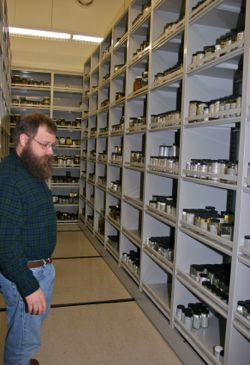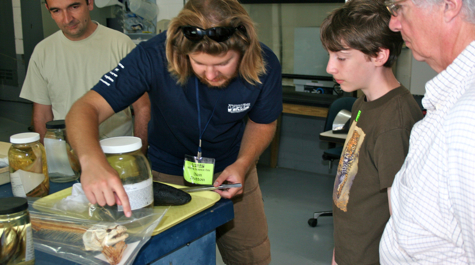VIMS Fish Collection to participate in national museum program
The Nunnally Ichthyology Collection at the Virginia Institute of Marine Science has been selected to participate in the Museum Assessment Program, which offers guided self-study and on-site consultation with a museum professional to help VIMS staff better serve both the scientific community and citizens of Virginia and the Chesapeake Bay watershed.
The Museum Assessment Program (MAP) is funded by the federal Institute of Museum and Library Services (IMLS) and administered by the American Alliance of Museums. As part of the IMLS National Leadership program, MAP advances best practices and fosters improvement in museums nationwide. MAP is a self-motivated endeavor; application to and participation is initiated by each local institution, and those accepted invest considerable human and institutional resources into the assessment. Leading VIMS' participation in the program is Collection Manager and research assistant professor Sarah Huber.
 The Nunnally Ichthyology Collection is an integral part of VIMS’ three-part mission of research, education, and advisory service and serves a broad community of basic and applied research scientists and fisheries managers, as well as providing an important resource for local community outreach. Through its 60-year history, the Collection has grown from an un-catalogued teaching collection to become the largest repository for freshwater, Chesapeake Bay, and coastal fishes in the Commonwealth of Virginia. This growth has been achieved through the research and collection programs of its curators, other VIMS faculty and staff, and graduate students, as well as through acquisition of orphaned collections.
The Nunnally Ichthyology Collection is an integral part of VIMS’ three-part mission of research, education, and advisory service and serves a broad community of basic and applied research scientists and fisheries managers, as well as providing an important resource for local community outreach. Through its 60-year history, the Collection has grown from an un-catalogued teaching collection to become the largest repository for freshwater, Chesapeake Bay, and coastal fishes in the Commonwealth of Virginia. This growth has been achieved through the research and collection programs of its curators, other VIMS faculty and staff, and graduate students, as well as through acquisition of orphaned collections.
Dr. Eric J. Hilton, Curator of the Nunnally Ichthyology Collection at VIMS says, “Our collection of fishes at VIMS is a tremendous resource for science and outreach. In recent years we've made significant strides in curating and digitizing the collection, but with the guidance of the Museum Assessment Program we will be able to move even more efficiently and effectively into the future.”
MAP is a confidential process of self-study, peer review, and implementation. Museums use the assessment process to strengthen operations, build capacity, and enhance communication throughout the organization and in response to community needs. Small and mid-sized museums of all types—including art, history, science and technology, children’s, natural history, historic houses, nature centers, botanical gardens, and zoos—participate.

“Choosing to be part of the MAP program is indicative of the commitment to civic involvement, public service, and overall excellence on the part of VIMS,” says American Alliance of Museums president Ford W. Bell. “Studies have shown America’s museums to be among the country’s most trusted and valued institutions. MAP is designed to make them even better.”
Since its creation in 1981, MAP has served more than 4,300 museums. It is supported through a cooperative agreement with IMLS, the primary source of federal support for the nation’s 123,000 libraries and 17,500 museums. AAM represents the nation’s entire museum community and has been dedicated to promoting excellence within the museum field for more than 100 years.



